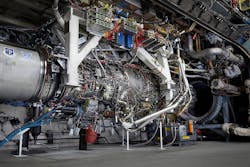GE Concludes Tests on Potential F-35 Replacement Engine
GE Aviation completed testing of its first XA100 adaptive-cycle engine, one of the proposed new power-plants for the Lockheed Martin F-35. The XA100 is a three-stream adaptive-cycle engine that can adjust the bypass ratio and fan pressure to increase fuel efficiency or thrust, depending on the scenario.
The new engine was developed by the GE Edison Works. Testing started last December at GE’s altitude testing center in Evendale, Ohio, and according to the developer the engine’s performance and mechanical behavior were consistent with pre-test predictions and in line with the U.S. Air Force’s Adaptive Engine Transition Program (AETP) goals.
“This was the most heavily instrumented engine test in both GE and U.S. Air Force history. We were able to obtain an immense amount of high-quality test data proving out the engine’s capabilities and demonstrating a good return on the Air Force’s investment,” according to Davie Tweedie, GE Edison Works’ general manager for Advanced Combat Engines.
The USAF initiated the AETP in 2016 to develop and test adaptive cycle engines, with one potential application being the re-engining of the F-35. GE Aviation (XA100) and Pratt & Whitney (XA101) were awarded contracts to develop 45,000-lbf (200-kN) class demonstrators.
According to GE Aviation, the XA100 combines an adaptive engine cycle; a “third-stream architecture” for high-thrust capability and a high-efficiency mode to optimize fuel use; and extensive use of advanced component technologies, including ceramic matrix composites (CMC), polymer matrix composites (PMC), and additive manufacturing.
These innovations increase thrust 10%, improve fuel efficiency by 25%, and provide significantly more aircraft heat dissipation capacity, all within the same physical envelope as current propulsion systems, GE detailed.
Assembly of a second prototype XA100 engine is underway, and testing on that engine expected to begin later this year.
“We were exceptionally pleased with how the engine performed throughout the test,” according to Tweedie, GE Edison Works’ general manager for Advanced Combat Engines. “Bringing a new centerline fighter engine to test for the first time is a challenging endeavor, and this success is a testament to the great team that worked so hard to get us here. We’re looking forward to working with the Air Force and other stakeholders to identify the next steps toward bringing this revolutionary capability out of the test cell and into the hands of the warfighter.”
